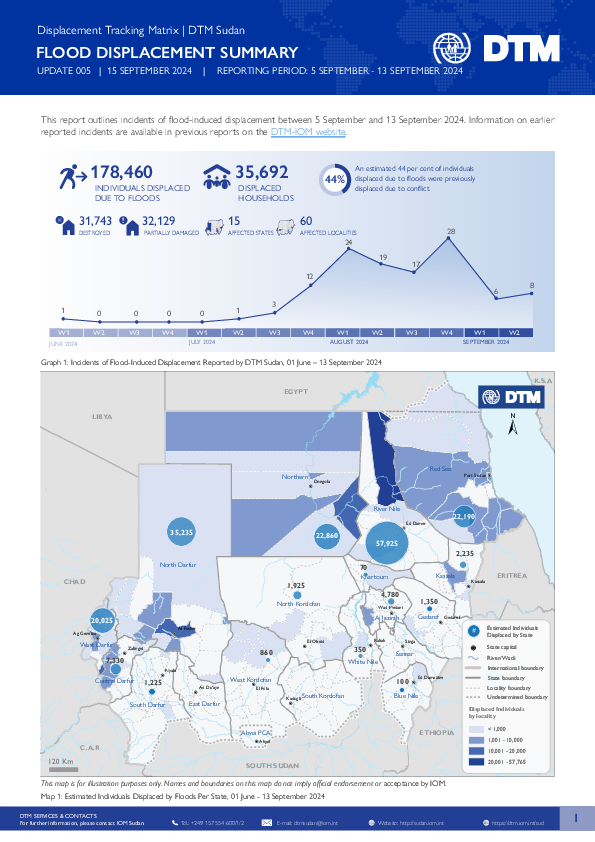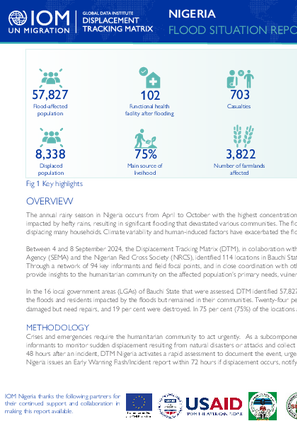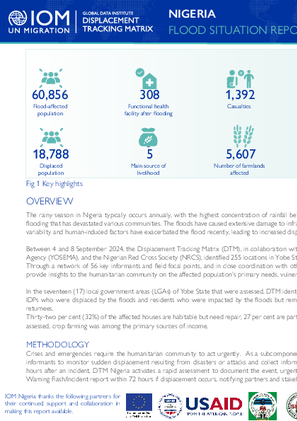-
Countries
-
Data and Analysis
-
Special Focus
-
Crisis Responses
No

Contact
DTM Ethiopia, DTMEthiopia@iom.int
Language
English
Location
Ethiopia
Period Covered
Jul 01 2024
Jul 31 2024
Activity
- Flow Monitoring
In July 2024, a total of 42,688 movements were observed across the six flow monitoring points (FMPs) in Ethiopia. This represents a 30.1% increase in daily average movements in comparison with June 2024 when an average of 1,058 movements per day were observed.
The ratio between outgoing movements (58.9% or 25,123 individuals) during July and incoming movements (41.1% or 17,565 individuals) shows a higher share of outgoing movements compared to the month of June. Historically, recorded outflows have been higher than inflows.

Contact
DTM Sudan; dtmsudan@iom.int
Language
English
Location
Sudan
Period Covered
Sep 05 2024
Sep 13 2024
Activity
- Mobility Tracking
- Event Tracking
The Flood Displacement Summary summarizes DTM updates on incidents of flood-induced displacement across Sudan.
Between 01 June and 13 September 2024, DTM Sudan reported 119 incidents of heavy rain and floods that triggered sudden displacement in Sudan. Rain and floods displaced an estimated 178,460 individuals (35,692 households) from locations across 15 different states in Sudan.
This report outlines incidents of flood-induced displacement between 05 September and 13 September 2024. Further information on earlier reported incidents is available on the DTM-IOM Sudan website.
Highlights
- DTM observed eight incidents of flood-induced displacement between 05 September and 13 September 2024.
- These reported incidents triggered the displacement of an estimated 5,940 individuals (1,188 households).
- Approximately 1,349 structures were either destroyed or partially damaged due to rain or floods.
- An estimated 44 per cent of individuals displaced due to floods were already displaced due to conflict prior to the onset of floods.

Contact
dtmhaiti@iom.int
Language
English
Location
Haiti
Period Covered
Sep 10 2024
Sep 13 2024
Activity
- Mobility Tracking
- Event Tracking
This information was collected following armed clashes in the neighborhoods of Boston in the municipality of Cité Soleil, which occurred on 11
September 2024 and in the neighborhood of 2nd Cité Saint Martin in the municipality of Delmas, on 10 September 2024. A total of 2,327
individuals were displaced as a result of these clashes, with 2,061 due to ones in Boston and 266 due to those in 2nd Cité Saint Martin. The
majority of the displaced persons (55%) took refuge with host families, while 45% in sites (1,053 individuals in 4 sites, including 1 site existing prior to these incidents and 3 newly established sites).

Contact
DTM Nigeria, iomnigeriadtm@iom.int
Language
English
Location
Nigeria
Period Covered
Sep 04 2024
Sep 09 2024
Activity
- Mobility Tracking
- Event Tracking
Between 4 and 9 September 2024, the Displacement Tracking Matrix (DTM), in collaboration with the National Emergency Management Agency (NEMA), the Gombe State Emergency Management Agency (GOSEMA), and the Nigerian Red Cross Society (NRCS), identified 42 locations in Gombe State that were impacted by floods or received internally displaced persons (IDPs) due to the flooding.
In the eight (8) local government areas (LGAs) of Gombe State that were assessed, DTM identified 14,910 individuals in 1,741 households affected by the floods. The floods displaced IDPs and residents impacted remained in their communities. The affected population included 2,994 individuals and 339 IDPs. Thirty-eight per cent (38%) of the affected houses are habitable but need repair, twenty per cent of the houses are partially damaged but need repairs and 22 per cent of the houses are destroyed. In 93 per cent (93%) of the locations assessed, crop farming was among the primary sources of income.

Contact
DTM Nigeria, iomnigeriadtm@iom.int
Language
English
Location
Nigeria
Period Covered
Sep 03 2024
Sep 09 2024
Activity
- Mobility Tracking
- Event Tracking
Between 3 and 9 September 2024, the IOM Displacement Tracking Matrix (DTM), in collaboration with the National Emergency Management Agency (NEMA), the Adamawa State Emergency Management Agency (ADSEMA), and the Nigerian Red Cross Society (NRCS), identified 38 locations in Adamawa State that were impacted by floods or received internally displaced persons (IDPs) due to the flooding.
In the nine (9) LGAs of Adamawa State that were assessed, DTM identified 24,169 individuals in 4,373 households affected by the floods. These individuals included IDPs who were displaced by the floods and residents who were impacted by the floods but remained in their communities. The affected population included 7,074 individuals and 3,120 returnees. Twenty-two per cent (22%) of the affected houses are habitable but need repair, thirty-one per cent (31%) of the houses are partially damaged but need repairs, and 18 per cent (18%) of the houses are destroyed. In eighty-two per cent (82%) of the locations assessed, crop and vegetable farming were among the primary sources of income.

Contact
DTM Nigeria, iomnigeriadtm@iom.int
Language
English
Location
Nigeria
Period Covered
Sep 04 2024
Sep 08 2024
Activity
- Mobility Tracking
- Event Tracking
Between 4 and 8 September 2024, the Displacement Tracking Matrix (DTM), in collaboration with the National Emergency Management Agency (NEMA), the Taraba State Emergency Management Agency (TSEMA), and the Nigerian Red Cross Society (NRCS), identified 56 locations in Taraba State that were impacted by floods or received internally displaced persons (IDPs) due to the flooding.
In the seven (7) Local Government Areas (LGAs) of Taraba State that were assessed, DTM identified 32,319 individuals in 7,349 households affected by the floods. These individuals included IDPs displaced by the floods and residents impacted by the floods but remained in their communities. The affected population included 1,741 displaced individuals and 232 returnees. Twenty per cent (20%) of the affected houses are habitable but need repair, 12 per cent are partially damaged and need repairs, and nine per cent are completely destroyed. In 77 per cent of the locations assessed, crop farming was among the primary sources of income.

Contact
DTM Nigeria, iomnigeriadtm@iom.int
Language
English
Location
Nigeria
Period Covered
Sep 04 2024
Sep 08 2024
Activity
- Mobility Tracking
- Event Tracking
Between 4 and 8 September 2024, the Displacement Tracking Matrix (DTM), in collaboration with the National Emergency Management Agency (NEMA), the Bauchi State Emergency Management Agency (SEMA) and the Nigerian Red Cross Society (NRCS), identified 114 locations in Bauchi State that were impacted by floods or received internally displaced persons (IDPs) due to the flooding.
In the 16 local government areas (LGAs) of Bauchi State that were assessed, DTM identified 57,827 individuals in 9,620 households affected by the floods. These individuals included IDPs displaced by the floods and residents impacted by the floods but remained in their communities. Twenty-four per cent (24%) of the affected houses are habitable but need repair, repairs, 18 per cent were partially damaged but need repairs, and 19 per cent were destroyed. In 75 per cent (75%) of the locations assessed, crop farming was among the primary sources of income.

Contact
DTM Nigeria, iomnigeriadtm@iom.int
Language
English
Location
Nigeria
Period Covered
Sep 04 2024
Sep 08 2024
Activity
- Mobility Tracking
- Event Tracking
Between 4 and 8 September 2024, the Displacement Tracking Matrix (DTM), in collaboration with the National Emergency Management Agency (NEMA), the Niger State Emergency Management Agency (NSEMA), and the Nigerian Red Cross Society (NRCS), identified 71 locations in Niger State that were impacted by floods or received internally displaced persons (IDPs) due to the flooding.
In the eighteen (18) local government areas (LGAs) of Niger State that were assessed, DTM identified 16,559 individuals in 2,337 households affected by the floods. These individuals included IDPs displaced by the floods and residents impacted by the floods but remained in their communities. The affected population included 1,385 individuals and 272 displaced. Twenty-four per cent (24%) of the affected houses are habitable but need repair, sixteen per cent of the houses are partially damaged but need repairs and seven per cent are destroyed. In 86 per cent (86%) of the locations assessed, crop farming was among the primary sources of income.c

Contact
DTM Nigeria, iomnigeriadtm@iom.int
Language
English
Location
Nigeria
Period Covered
Sep 04 2024
Sep 08 2024
Activity
- Mobility Tracking
- Event Tracking
The rainy season in Nigeria typically occurs annually, with the highest concentration of rainfall between June and September. Many states have been impacted by hefty rains, resulting in significant flooding that has devastated various communities. The floods have caused extensive damage to infrastructure, crops, and shelters, severely affecting livelihoods and displacing many households. Climate variability and human-induced factors have exacerbated the flood recently, leading to increased displacement across Nigeria.
In the seventeen (17) local government areas (LGAs) of Yobe State that were assessed, DTM identified 60,856 individuals in 13,474 households affected by the floods. These individuals included both IDPs who were displaced by the floods and residents who were impacted by the floods but remained in their communities. The affected population included 18,788 displaced individuals and 567 returnees.
Thirty-two per cent (32%) of the affected houses are habitable but need repair, 27 per cent are partially damaged but need repairs, and 17 per cent are destroyed. In 75 per cent (75%) of the locations assessed, crop farming was among the primary sources of income.

Contact
DTM Nigeria, iomnigeriadtm@iom.int
Language
English
Location
Nigeria
Period Covered
Sep 04 2024
Sep 08 2024
Activity
- Mobility Tracking
- Event Tracking
The annual rainy season in Nigeria occurs from April to October with the highest concentration of rainfall. During July-August 2024, many states nationwide were impacted by hefty rains, resulting in significant flooding that devastated various communities. The floods caused extensive damage to infrastructure, crops, and shelters, severely affecting livelihoods and displacing many households. Climate variability and human-induced factors have exacerbated the flood recently, leading to increased displacement across Nigeria.
In the 20 local government areas (LGAs) of Jigawa State that were assessed, DTM identified 257,236 individuals in 42,603 households affected by the floods. These individuals included IDPs who were displaced by the floods and residents who were impacted by the floods but remained in their communities. The affected population included 94,893 displaced individuals.
Thirty-six per cent (36%) of the affected houses are habitable but need repair, forty-six per cent were partially damaged but need repairs, and 18 per cent were destroyed. In 96 per cent (96%) of the locations assessed, crop farming was among the primary sources of income.c
Pagination
- Previous page
- Page 47
- Next page
